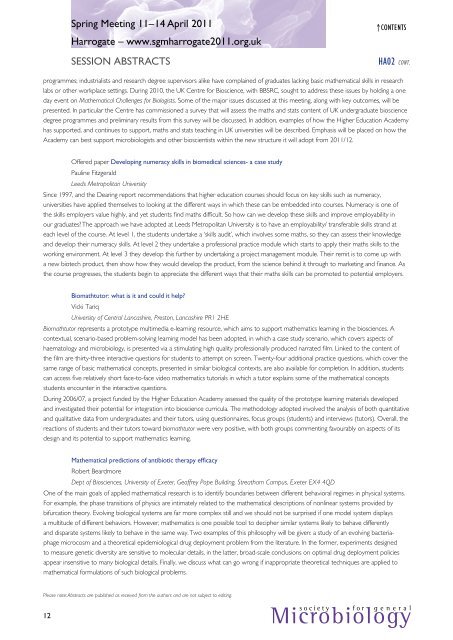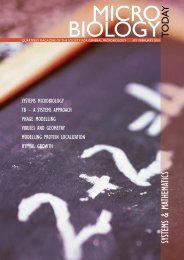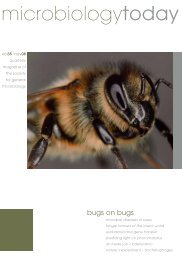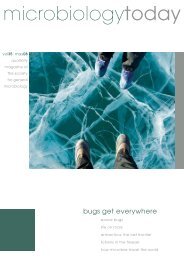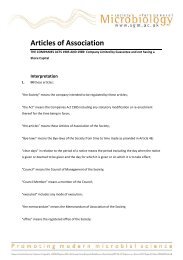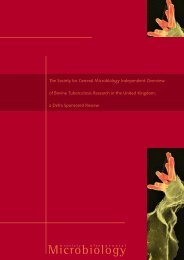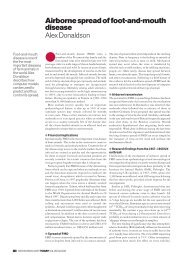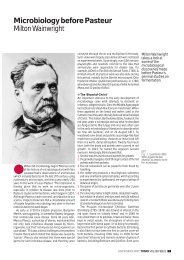Spring Conference 2011 - Society for General Microbiology
Spring Conference 2011 - Society for General Microbiology
Spring Conference 2011 - Society for General Microbiology
You also want an ePaper? Increase the reach of your titles
YUMPU automatically turns print PDFs into web optimized ePapers that Google loves.
Please note: Abstracts are published as received from the authors and are not subject to editing.<br />
12<br />
<strong>Spring</strong> Meeting 11–14 April <strong>2011</strong><br />
Harrogate – www.sgmharrogate<strong>2011</strong>.org.uk<br />
SESSION AbSTrACTS<br />
↑Contents<br />
HA02 Cont.<br />
programmes; industrialists and research degree supervisors alike have complained of graduates lacking basic mathematical skills in research<br />
labs or other workplace settings. During 2010, the uK Centre <strong>for</strong> Bioscience, with BBSrC, sought to address these issues by holding a one<br />
day event on Mathematical Challenges <strong>for</strong> Biologists. Some of the major issues discussed at this meeting, along with key outcomes, will be<br />
presented. in particular the Centre has commissioned a survey that will assess the maths and stats content of uK undergraduate bioscience<br />
degree programmes and preliminary results from this survey will be discussed. in addition, examples of how the Higher Education Academy<br />
has supported, and continues to support, maths and stats teaching in uK universities will be described. Emphasis will be placed on how the<br />
Academy can best support microbiologists and other bioscientists within the new structure it will adopt from <strong>2011</strong>/12.<br />
Offered paper Developing numeracy skills in biomedical sciences- a case study<br />
Pauline Fitzgerald<br />
Leeds Metropolitan University<br />
Since 1997, and the Dearing report recommendations that higher education courses should focus on key skills such as numeracy,<br />
universities have applied themselves to looking at the different ways in which these can be embedded into courses. Numeracy is one of<br />
the skills employers value highly, and yet students find maths difficult. So how can we develop these skills and improve employability in<br />
our graduates?The approach we have adopted at leeds Metropolitan university is to have an employability/ transferable skills strand at<br />
each level of the course. At level 1, the students undertake a ‘skills audit’, which involves some maths, so they can assess their knowledge<br />
and develop their numeracy skills. At level 2 they undertake a professional practice module which starts to apply their maths skills to the<br />
working environment. At level 3 they develop this further by undertaking a project management module. Their remit is to come up with<br />
a new biotech product, then show how they would develop the product, from the science behind it through to marketing and finance. As<br />
the course progresses, the students begin to appreciate the different ways that their maths skills can be promoted to potential employers.<br />
biomathtutor: what is it and could it help?<br />
Vicki Tariq<br />
University of Central Lancashire, Preston, Lancashire PR1 2HE<br />
Biomathtutor represents a prototype multimedia e-learning resource, which aims to support mathematics learning in the biosciences. A<br />
contextual, scenario-based problem-solving learning model has been adopted, in which a case study scenario, which covers aspects of<br />
haematology and microbiology, is presented via a stimulating high quality professionally produced narrated film. linked to the content of<br />
the film are thirty-three interactive questions <strong>for</strong> students to attempt on screen. Twenty-four additional practice questions, which cover the<br />
same range of basic mathematical concepts, presented in similar biological contexts, are also available <strong>for</strong> completion. in addition, students<br />
can access five relatively short face-to-face video mathematics tutorials in which a tutor explains some of the mathematical concepts<br />
students encounter in the interactive questions.<br />
During 2006/07, a project funded by the Higher Education Academy assessed the quality of the prototype learning materials developed<br />
and investigated their potential <strong>for</strong> integration into bioscience curricula. The methodology adopted involved the analysis of both quantitative<br />
and qualitative data from undergraduates and their tutors, using questionnaires, focus groups (students) and interviews (tutors). Overall, the<br />
reactions of students and their tutors toward biomathtutor were very positive, with both groups commenting favourably on aspects of its<br />
design and its potential to support mathematics learning.<br />
Mathematical predictions of antibiotic therapy efficacy<br />
robert Beardmore<br />
Dept of Biosciences, University of Exeter, Geoffrey Pope Building, Streatham Campus, Exeter EX4 4QD<br />
One of the main goals of applied mathematical research is to identify boundaries between different behavioral regimes in physical systems.<br />
For example, the phase transitions of physics are intimately related to the mathematical descriptions of nonlinear systems provided by<br />
bifurcation theory. Evolving biological systems are far more complex still and we should not be surprised if one model system displays<br />
a multitude of different behaviors. However, mathematics is one possible tool to decipher similar systems likely to behave differently<br />
and disparate systems likely to behave in the same way.Two examples of this philosophy will be given: a study of an evolving bacteriaphage<br />
microcosm and a theoretical epidemiological drug deployment problem from the literature. in the <strong>for</strong>mer, experiments designed<br />
to measure genetic diversity are sensitive to molecular details, in the latter, broad-scale conclusions on optimal drug deployment policies<br />
appear insensitive to many biological details. Finally, we discuss what can go wrong if inappropriate theoretical techniques are applied to<br />
mathematical <strong>for</strong>mulations of such biological problems.<br />
s o c i e t y f o r g e n e r a l<br />
<strong>Microbiology</strong>


